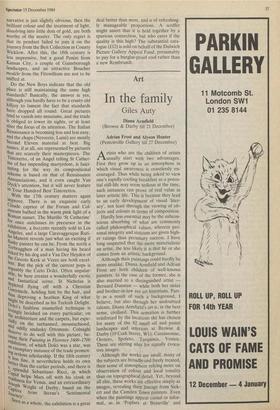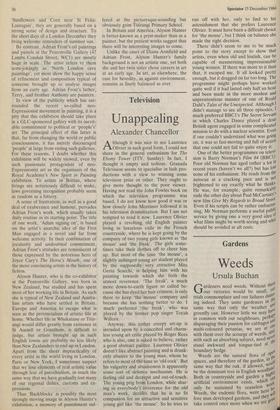Art
In the family
Giles Auty
Diana Armfield (Browse & Darby till 21 December) Adrian Frost and Alyson Hunter (Pentonville Gallery till 27 December)
Artists who are the children of artists usually start with two advantages. First they grow up in an atmosphere in which visual awareness is ceaselessly en- couraged. Thus while being asked to view one's rapidly cooling breakfast as a poten- tial still-life may seem tedious at the time, such instances can prove of real value in later artistic life. This is because they lead to an early development of visual 'liter- acy', not least through the viewing of ob- jects and colours in terms of composition.
Hardly less essential may be the subcon- scious absorbing of what are commonly called philosophical values, wherein per- sonal integrity and stoicism are given high- er ratings than pecuniary success. I have long suspected that the more materialistic an artist, the less likely it is that he or she comes from an artistic background.
Although their paintings could hardly be more unalike, Diana Armfield and Adrian Frost are both children of well-known painters. In the case of the former, she is also married to a distinguished artist — Bernard Dunstan — while both her sister and brother-in-law are art historians. Part- ly as a result of such a background, I believe, but also through her undoubted talents, Diana Armfield's art is, in the best sense, civilised. This sensation is further reinforced by the locations she has chosen for many of the 82 small oil and pastel landscapes and interiors at Browse & Darby (19 Cork Street, W1): Carcassonne, Orvieto, Spoleto, Tarquinia, Venice. These are stirring sites for equally evoca- tive images.
Although the works are small, many of the subjects are broadly and freely treated, their sense of atmosphere relying more on observation of colour and local tonality than on topographical detail. Yet, beyond all else, these works are effective simply as images, revealing their lineage from Sick- ert and the Camden Town painters. Even when the paintings appear casual or infor- mal, as in 'Poplars at Beauville' and 'Sunflowers and Corn near St Felix- Lauragais', they are generally based on a strong sense of design and structure. To the short days of a London December they bring welcome reminders of summer sun.
By contrast, Adrian Frost's oil paintings and pastels at the Pentonville Gallery (47 Lambs Conduit Street, WC1) are mostly huge in scale. The artist refers to them semi-jokingly as 'North London cave paintings', yet most show the happy sense of refinement and composition typical of someone brought up to analyse images from an early age. Adrian Frost's father, Terry, and brother Anthony are painters.
In view of the publicity which has sur- rounded the recent so-called neo- Expressionist movement in painting, it is a pity that this exhibition should take place in a GLC-sponsored gallery with its inevit- able commitment to political or 'people's' art. The principal effect of this latter is that, far from changing the world or public consciousness, it has merely discouraged 'people' at large from visting such galleries. For these reasons, I doubt whether this exhibition will be widely viewed, even by such passionate protagonists of neo- Expressionist art as the organisers of the Royal Academy's New Spirit in Painting exhibition. To artists in Britian, where livings are notoriously difficult to make, laws governing recognition probably seem as random as a lottery.
A sense of frustration, as well as a good deal of exuberance and humour, pervades Adrian Frost's work, which usually takes daily routine as its starting point. The title of one work, 'Adam signing on', is based on the artist's anarchic idea of the First Man engaged in a novel and far from welcome activity. In their combination of jocularity and undoubted commitment, Adrian Frost's attitudes are reminiscent of those expressed by the notorious hero of Joyce Cary's The Horse's Mouth, one of the more convincing artists in the history of fiction.
Alyson Hunter, who is the co-exhibitor at the Pentonville Gallery, was born in New Zealand, but studied and has spent most of her working life in Britain. As such she is typical of New Zealand and Austra- lian artists who have settled in Britain, Europe and America to escape what is seen as the provincialism of artistic life at home. Whether life in Whakatane or Titir- angi would differ greatly from existence in St Austell or Grantham, is difficult to judge, but artists brought up in such English towns are probably no less likely than New Zealanders to end up in London. Apart from the sheer impracticality of every artist in the world living in London, Paris or New York, I sometimes suspect that we lose elements of real artistic value through fear of parochialism, in much the same way that we have gradually lost many of our regional dishes, customs and ex- pressions.
Thus 'Backblocks' is possibly the most strongly moving image in Alyson Hunter's exhibition; a memory of punishment suf- fered at the picturesque-sounding but obviously grim Titirangi Primary School.
In Britain and America, Alyson Hunter is better-known as a print-maker than as a painter, but the present works suggest that there will be interesting images to come.
Unlike the cases of Diana Armfield and Adrian Frost, Alyson Hunter's family background is not an artistic one, yet both she and her twin sister chose careers in art at an early age. In art, as elsewhere, the case for heredity, as against environment, remains as finely balanced as ever.



















































 Previous page
Previous page